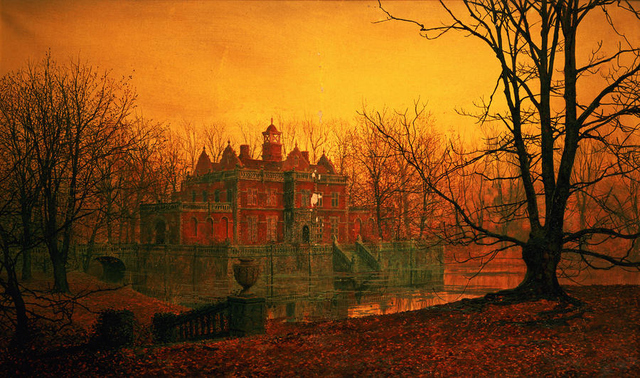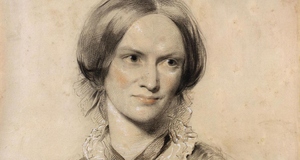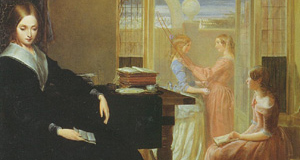Featured Article:Trauma Reenactment in the Gothic Loop: A Study on Structures of Circularity in Gothic Fiction
By
2014, Vol. 6 No. 05 | pg. 1/4 | »
IN THIS ARTICLE
Gothic Fiction as a Narrative of RetrospectionEver since its original emergence, Gothic fiction has been shaped by a unique narrative direction that is often described by scholars and readers alike as retrospective, repetitive, or circular in nature. Gothic texts progress as if through a series of flashbacks, always reviving deeds of the past in order to point out a problem, which, however strongly rooted in some ancient heritage, prevails in the present and calls for immediate resolution. David B. Morris defines the typically Gothic vision of history as one where “the past interpenetrates the present time, as if events were never entirely the unique and unrepeated product of human choices, but rather the replication of an unknown or buried pattern” (Morris 304). A similar view on progression is depicted, quite visually, by Charlotte Perkins Gilman’s short story “The Yellow Wallpaper,” in which the very pattern chosen for the famous tapestry follows a similarly transgressive, circular direction, as described by the narrator of the tale: You think you have mastered it, but just as you get well underway in following, it turns a back-somersault and there you are. It slaps you in the face, knocks you down, and tramples upon you. It is like a bad dream. (Gilman 9) The curious dynamism that Gilman’s narrator points out here matches the narrative pattern, as well as the historical perspective, one may find in most Gothic tales. This unique discursive tendency, which is characterized by literary ‘back-somersaults’ and which could be referred to as ‘the Gothic loop,’ has become a key feature of the Gothic tradition and is perhaps one of the most underlying structural principles any Gothic text relies upon in its rendering of fictional events. Within the frame of the 'Gothic loop' a previously repressed event of the past suddenly imposes itself upon the present and — in an attempt to haunt the minds of the protagonists until they submit to face the challenge which the processing of that past memory has to offer — refuses to leave. The Gothic narrative loop—as it could be termed—is thus curved by a forceful intrusion of past events into the protagonist’s present-day reality. Its emergence carries several literary functions, the most crucial being the evocation of a highly active, even dramatic form of melancholy reverie. Through that, the past—often presented as a site burdened with historical and/or personal crisis—not only regains its sense of immediacy and relevance, but also acquires a revised perspective. This intellectually fruitful effect of the temporal loop has been rediscovered by several authors of the Gothic convention who frequently utilize the retrospective direction of Gothic narratives for a particularly interesting purpose, that of personal and socio-cultural trauma reenactments. By considering the novel Kindred by Octavia E. Butler from a Gothic perspective, it is my goal to discuss the nature of the Gothic loop, with a special focus on its potential to reshape cultural and historical identities (especially ones having been subject to historical traumas) through a series of literary revisitations. I would also like to suggest that once identifying the temporal loop as a structure able to encompass the central problematic of the traditional Gothic tale, it becomes possible, and even necessary, to re-evaluate the heavily criticized and frequently devalued repetitiveness of Gothic texts.
As it appears then, the Gothic loop could be defined as a discursive element, a fictional time and space of various suspensions when/where certain past or present traumas must be continuously re-experienced and finally resolved—with horror and suffering involved on the part of the protagonists—in order to produce an improved (re)starting point in the narrative. Within the frame of the Gothic loop a previously repressed event of the past suddenly imposes itself upon the present and refuses to leave in an attempt to haunt the minds of the protagonists until they submit to face the challenge which the processing of that past memory has to offer. Consider how, for instance, in Toni Morrison’s Beloved the past literally walks into the protagonists’ present time, in the form of an incarnated ghost (not coincidentally arriving at the time of the carnival season), bringing a host of unwelcome memories with herself that neither main character Sethe, nor her family are, at first, ready to resolve. Their home, Bluestone Road 124, is described as a space condemned to an eternal state of temporal suspension, with its inhabitants unable to move forward in their lives due to the repetitively haunting presence of former events. The act of moving becomes a crucial, recurrent motif of the novel and also a seemingly impossible aim for the characters themselves. When Sethe proposes the idea of leaving the house behind, the answer she receives from Baby Suggs formulates the central crisis of their story: “What’d be the point?” Baby Suggs replies, “Not a house in the country ain’t packed to its rafters with some dead Negro’s grief. We lucky this ghost is a baby” (5). Moving in a physical sense does not provide a solution to the kind of haunting Morrison’s characters experience. What is really required is a form of psychological movement; a liberation of one’s identity from a past whose unresolved matters deprive the self from its own legitimacy within the present time. Sethe has memories, even re-memories of her past (a concept that refers not merely to a repetition of memory, but to a practice of extremely involved re-experiencing), but she is unable to conceive of a future as long as her character is defined by an ever-returning, aggressively present personal history. Thus, Morrison’s characters decide to turn to the past, and the more their story evolves in the course of the novel, the further they venture back in time to the heart of their present-day problems. While often found as an underlying narrative direction, the Gothic loop can also be recognized in the Gothic tendency of repetitions. The Gothic genre itself progresses in a looping pattern, periodically reviving itself and returning to its previous concerns whose resolution seems to call for constant and numerous reiterations. Since imagery, character stereotypes, settings and even plotlines tend to imitate each other in Gothic discourse, the genre, especially its early form, has gained a negative fame for being too predictable and static, the kind of popular literature that could be summarized on the basis of an inventory of necessary tropes. While the Gothic literary style has, without doubt, adopted a habit of self-repetition, it is important to point out that whatever is being continuously refrained by Gothic narratives in such a compulsive manner is repeated not simply for the sake of mere entertainment, but for a more complex, generic reason. In my analysis I want to focus primarily on narrative loops, disregarding other forms of repetition, such as repetitions of character types or other frequent tropes. One of my main concerns is to consider the various factors that differentiate Gothic loops from similar narrative structures present in other literary traditions. In other words, it is crucial to find the specifically Gothic aspect of such temporal narrative loops in order to account for their recurrent use in Gothic discourse. Additionally, this study also endeavors to examine one particularly significant feature of the Gothic loop, namely, its potential ability to provide a literary space for trauma reenactments and dramatic performances of one’s historical, cultural and personal identity.Continued on Next Page » Suggested Reading from Inquiries Journal
Inquiries Journal provides undergraduate and graduate students around the world a platform for the wide dissemination of academic work over a range of core disciplines. Representing the work of students from hundreds of institutions around the globe, Inquiries Journal's large database of academic articles is completely free. Learn more | Blog | Submit Latest in Literature |



















